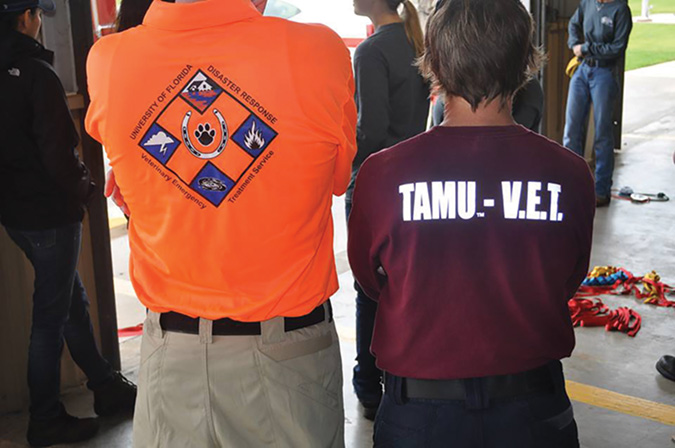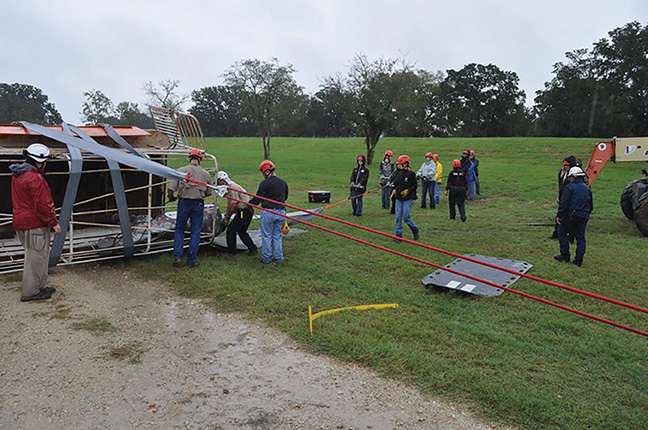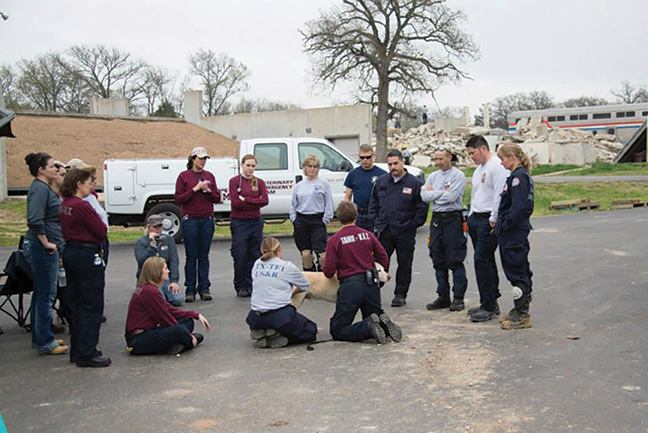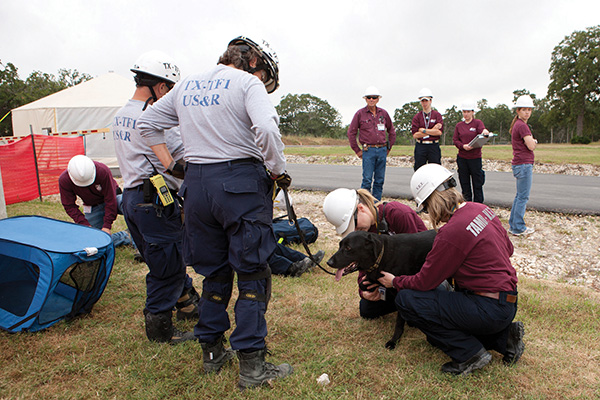Collaboration on the Front Lines
When disaster strikes, animals and people are put in harm’s way, and a strong collaborative response effort must be launched to save lives and put families and communities on the road to recovery. Those called into action represent a wide scope of experience and expertise, including law enforcement, fire fighting, search and rescue teams, medical personnel, service and support organizations, government agencies, and, more recently, veterinary medicine. The diversity of response organizations and the disasters to which they respond have led to one of the nation’s most distinctive collaborative efforts, housed at Texas A&M University.
 Search and rescue teams working in Louisiana and the upper Texas coast in response to Hurricanes Katrina and Rita in 2005 were faced with not only rescuing a significant number of stranded survivors, but also dealing with the animals that had been left behind or were stranded with their owners. As a further complication, the environmental conditions in which these special teams worked put additional stress on both the human team members and their canine partners.
Search and rescue teams working in Louisiana and the upper Texas coast in response to Hurricanes Katrina and Rita in 2005 were faced with not only rescuing a significant number of stranded survivors, but also dealing with the animals that had been left behind or were stranded with their owners. As a further complication, the environmental conditions in which these special teams worked put additional stress on both the human team members and their canine partners.
Following these two disasters, legislation was enacted that dictated companion animals must be considered and provided for in the event of a disaster. How this was to be accomplished was not defined and was left to individual jurisdictions to decide.
“After Katrina, the PETS [Pets Evacuation and Transportation Standards Act] legislation was passed stating that no one would be left behind because of a companion animal,” said Jeff Saunders, operations chief at Texas Task Force 1 (TX-TF1). “That is fine for the people who are home with their pets, but many times we find that the people have evacuated or couldn’t return to their residence because of a mandatory evacuation, but the animals are still there. In those cases, search and rescue teams, such as ours, are usually the first to locate these animals.”
Hurricane Rita and, later, Hurricane Ike brought a large volume of evacuees from the coastal areas to Texas A&M seeking shelter from the storms. During Rita, the Large Animal Hospital at the College of Veterinary Medicine & Biomedical Sciences (CVM) was turned into a human surge hospital within 72 hours of notice. Following that event, faculty, staff, and students from the college worked collaboratively with representatives from the College of Agriculture & Life Sciences to set up both a large animal shelter (at the Brazos County Expo Center) and a companion animal shelter at (Texas A&M’s Riverside Campus) to house pets and livestock evacuated from the coast in the face of Hurricane Ike. The need for veterinarians to play a role in disaster response was readily apparent.
 “The emphasis on pets and livestock impacted by these disasters underscored the need to include veterinarians in the response discussion,” said Dr. Wesley Bissett, associate professor in Large Animal Clinical Sciences and director of the Texas A&M Veterinary Emergency Team (VET). “As the only college of veterinary medicine in the state of Texas, and as a part of a land-grant university, it was our responsibility to find ways to be part of the solution to address animal issues in disaster.”
“The emphasis on pets and livestock impacted by these disasters underscored the need to include veterinarians in the response discussion,” said Dr. Wesley Bissett, associate professor in Large Animal Clinical Sciences and director of the Texas A&M Veterinary Emergency Team (VET). “As the only college of veterinary medicine in the state of Texas, and as a part of a land-grant university, it was our responsibility to find ways to be part of the solution to address animal issues in disaster.”
Bissett didn’t have to turn far to find assistance in developing what has become one of the largest and most sophisticated veterinary emergency response organizations in the country. Immediately after Hurricane Ike, he began conversations with the world-renowned TX-TF1, a response agency that also calls Texas A&M home. From there, what began as a conversation has led to a collaborative effort that not only addresses animals in disaster situations but also ensures the health and welfare of those animals that serve side by side with their human response partners.
“First and foremost, the power of this collaboration, what makes it unique and special, is that it is the only one in the country that we know of,” said Saunders. “Other teams have veterinarians that deploy with their personnel, but nothing is as robust and effective as TX-TF1 and the VET. Now, as our teams come across stranded animals, we are able to GPS the location to local animal control or to the VET. This helps alleviate some of the loose or stranded pet issues by working as a team with other response groups, and we can still focus on our search and rescue efforts.”
Saunders and his team recognized from their extensive deployment experience the need for veterinary support on the ground to assist in assessing loose and stranded animals and evacuating them to a shelter or veterinary hospital where they could be reunited with their owners.
“Working in disaster situations requires an integrated response,” said Bissett. “From that perspective, as a response team, we have the veterinary expertise, but we also had much to learn about becoming a true response unit. We were fortunate to find a response partner the caliber of TX-TF1 to help guide us as we began to mature to the point where we are now.”
While the PETS legislation placed the focus on loose and stranded companion animals, another member of TX-TF1 recognized the value of working with the VET, but for a different reason. Susann Brown, search team manager for TX-TF1, coordinates the training and deployment calls for the canine search and rescue teams that serve with TX-TF1. The hazardous environments in which these teams operate have always presented medical concerns for Brown and these special team members. Collaborating with the VET represented a new opportunity to further ensure the safety and well-being of these working dogs.
 Dr. Deb Zoran, medical operations chief for the VET, had been working with Brown since the late 1990s as the on-call veterinarian for pre-deployment exams for the search and rescue dogs. In addition, she provided first-aid lectures to the handlers during Federal Emergency Management Agency (FEMA) training weekends.
Dr. Deb Zoran, medical operations chief for the VET, had been working with Brown since the late 1990s as the on-call veterinarian for pre-deployment exams for the search and rescue dogs. In addition, she provided first-aid lectures to the handlers during Federal Emergency Management Agency (FEMA) training weekends.
“As the VET developed, and we created our fourth year rotation for veterinary medical students, we asked Susann about becoming their training partner and supporting the handler/canine teams when they had their bimonthly training sessions at Disaster City,” Zoran said. “This step represented that continuing evolution of two groups of people who were committed to the idea and finally found a way to make things work.”
Zoran added that most of the injuries from the training sessions come from the high drive of the working dogs, so it’s important to have that awareness and understanding of what the risks are, whether in a training rubble pile or on a deployment. The search and rescue dogs are asked to work in demanding and hazardous environments that are often contaminated, and while the handlers are able to wear personal protective equipment, the dogs cannot.
“The two greatest medical concerns for our dogs are injury and heat stress, and we have had problems with both,” said Brown. “Most of the injuries we have seen have been minor scrapes and cuts, but even a minor pad injury can make it difficult for a search dog to continue working. Heat stress is a much more pervasive problem and can put a dog out of commission for multiple shifts. Prior to working more closely with the VET, we have worked with medical personnel on our team to address the medical needs for both human and canine task force members.”
In 2011, most of Texas was experiencing some of the hottest and driest conditions recorded to date. Wildfires seemed to spring up in multiple places across the state, but the most memorable were the Bastrop Complex Wildfires. Started by what is believed to have been downed power lines sparking into the dried pine trees in the area, three separate fires burned together into one large blaze near the city of Bastrop, Texas, and destroyed more than 1500 homes. The canine search and rescue teams were asked to deploy and operate in this fiery environment, unlike any they had previously faced.
In this deployment, the standard booties available to search and rescue dogs were uncomfortable, and most of the dogs were able to remove them during operation. However, the VET was able to develop a unique booting solution that enabled the dogs to continue working on the hot ground while still protecting the sensitive pads of their feet.
Brown noted that solutions such as these are part of that depth of knowledge and expertise the members of the VET bring to the deployment.
“Having the VET on scene with us has made a tremendous difference in our ability to keep our dogs healthy and working during deployments. The members of the VET are able to quickly diagnose injuries and illness in our dogs, and can also provide recommendations concerning the risk of potential contaminants or hazards and possible ways to mitigate those risks.”
Caring for the search and rescue dogs as part of the collaboration between the VET and TX-TF1 is no small task. According to Saunders, there are 15 canine handlers, ten of whom are certified Canine Search Team – Live Find (pairing of a handler with a dog) and five of which are certified Canine Search Team – Human Remains Detection. In addition, canine teams from all across the country representing 68 participating agencies bring their dogs to Disaster City in College Station for training and FEMA certification dates.
“These canine/handler teams are very dedicated to their job,” Zoran said. “The selfless service they provide is awesome because this is not their ‘day job’; they all have other jobs and other lives. The amount of time and energy and money they give to become FEMA US&R; [Urban Search and Rescue] certified handler/canine teams is unbelievable. They are special people with very special dogs. To be considered working with them and caring for their dogs is one of the most humbling and gratifying things I can imagine.”
Because of the significant investment of time and training that each handler puts into getting a dog certified as a search and rescue dog, Brown emphasized the value of veterinary support for those training days as well as in the field.
 “Much of the incidental cost of getting a dog FEMA certified is the responsibility of the handler,” said Brown. “These handlers travel to College Station at least once a month for training, but will also travel to other locations to provide their dogs a variety of search areas to train in. It is difficult to put an exact figure on the handler’s training time and expenses, but it is significant. Having a partnership that allows veterinary support during training at our location has become a great value to the team.”
“Much of the incidental cost of getting a dog FEMA certified is the responsibility of the handler,” said Brown. “These handlers travel to College Station at least once a month for training, but will also travel to other locations to provide their dogs a variety of search areas to train in. It is difficult to put an exact figure on the handler’s training time and expenses, but it is significant. Having a partnership that allows veterinary support during training at our location has become a great value to the team.”
As the capacity and capabilities of the VET have evolved, the nature of the collaboration between these response partners has also grown to include the development of a Large Animal Technical Rescue training program designed to educate first responders and veterinarians on the tactics and skills necessary to safely rescue large animals in crisis.
“The impact of disasters is not limited to people and pets,” said Bissett. “Texas is number one in the nation in the numbers of cattle and horses. There are also livestock concerns in other parts of the country as well. Working with our response partners at the Texas A&M Engineering Extension Service (TEEX), we have been able to certify trainers and to supplement the curriculum for a dynamic large animal rescue course that will ensure first responders and veterinarians will have access to the knowledge and skills needed to rescue large animals in a safe and humane manner.”
Beginning with early efforts at Large Animal Technical Rescue training in 2008, the interest in and need for a more focused effort has been recognized. In 2012, the first class fully integrating veterinary medicine with first responders was presented by a team from the University of California at Davis led by Dr. John Madigan and coordinated by Dr. Leslie Easterwood, clinical assistant professor in Large Animal Clinical Sciences at the CVM and member of the VET.
“Large Animal Technical Rescue is a chapter in the FEMA First Responder certification curriculum,” said Easterwood. “Our objective from the very beginning was to develop a team of instructors made up of VET and TEEX members that would be able to present the course to first responders and veterinarians.”
After the initial course in 2012, interest in certification grew. In 2014, John Haven, head of the Veterinary Teaching Hospital and director of the Veterinary Emergency Treatment Service at the University of Florida, and assistant instructor Josh Fleming came to Texas A&M to provide instructor certification training to identified members of the VET and TEEX. The four-day course consisted of two days of instructor training followed by an additional two days where those being certified as instructors were given the opportunity to instruct others.
“Attending the class and developing our instructional skills in the field together with our partners in TEEX gave us the opportunity to better understand the perspectives and expertise across disciplines,” said Christopher Mabry, logistics supervisor and graduate student. “Our team members benefitted from learning more about the safety and logistics needed for operating in the field from the first responders’ experience, while at the same time, the first responders learned more about the health and welfare concerns of animals that are needing to be rescued.
According to Easterwood, approximately eight VET members attended the course. In addition, David Rosier, training coordinator for TEEX, noted that eight TEEX instructors were also certified.
“The goal of this program was to bring together the rescue profession and the veterinary profession to provide safe rescue of animals in need,” said Rosier. “The class was truly a joint effort that enabled both to give their expertise to the class. Our students in future sessions will be emergency services such as law enforcement, fire service, animal control, veterinarians, large animal facility operators, animal rescue groups, large animal transporters, and potentially large/small animal owners. Combining rescue knowledge with animal care expertise will allow us to all work together during a rescue.”
The first course in Large Animal Technical Rescue will be offered as part of the Spring Fire School that TEEX hosts every year, and the newly certified instructors from both TEEX and the VET will teach portions of the course.
“This will allow for the strengths of both groups to be used to teach different parts of the course,” said Easterwood, “which makes the course relevant to both first responders and veterinarians.”
Disasters, large or small, may strike at any time, and the animals and their owners feel the impact whether it’s a single pet or a large herd of cattle. With a mission of “serving our state and nation every day,” the leadership of the Texas A&M Veterinary Emergency Team will continue to build productive collaborations and partnerships, which will enhance the ability to respond to those animals in need.


